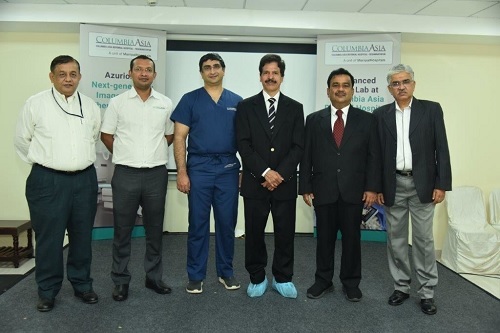
Door-to-Balloon time refers to the time it takes for a heart attack victim to receive a treatment called primary angioplasty from the moment they walk through the hospital doors
Columbia Asia Referral Hospitals Yeshwanthpur (A Unit of Manipal Hospitals), announced the launch of a new cath lab unit to highlight and demonstrate the importance of ‘Door-to-Balloon’ time during cardiac emergencies.
At least 4.77 million Indians die from heart attacks every year. One of the biggest barriers to survival is getting the right treatment promptly. Fortunately, recent developments in emergency care for individuals suffering from a heart attack has helped to improve overall patient outcomes. Door-to-Balloon time plays an enormous part in reducing the number of heart attack fatalities. For every single minute, a person waits between the time they first feel symptoms of a heart attack to the time they are treated, heart cells could be irreversibly dying. A heart attack is a life-and-death emergency–every second counts. Today, more people than ever before are walking away from the hospital with a new lease of life because of new treatments like primary angioplasty. Getting to help as fast as possible will help the cardiologist to meet the 90-minute Door-to-Balloon time goal so that the victim can get angioplasty done in time.
Highlighting the importance of Door-to-Balloon time, Dr Karthik Vasudevan, Senior Consultant Interventional Cardiology at Columbia Asia Referral Hospitals, Yeshwanthpur (A Unit of Manipal Hospitals), said, “Our unit is equipped with state-of-the-art facilities and well qualified and experienced medical team that enables us to reduce the Door-to-Balloon time to as short as 40-50 minutes with an average time of below 50 minutes for most procedures as opposed to the standard 90 minutes frame. Recognising the signs and symptoms of a heart attack plays a crucial role in saving the victim’s life. In many cases, those suffering from heart attacks may not recognise their symptoms. Sometimes a heart attack can seem like a wicked case of heartburn which is misunderstood for acidity and gastritis.”
Door-to-Balloon time refers to the time it takes for a heart attack victim to receive a treatment called primary angioplasty from the moment they walk through the hospital doors. Primary angioplasty is an endovascular procedure that widens narrowed or obstructed veins or arteries. This crucial life-saving tool is an empty, collapsed balloon catheter that is passed over a wire into narrowed locations and inflated to a particular size, thus opening the block in the arteries. Even patients who are not sure they’re experiencing a heart attack should get themselves checked out if they experience these symptoms. It’s always better to risk embarrassment than to delay treatment when it comes to a heart attack and failure.
“When a heart attack strikes, every minute matters. At Columbia Asia Referral Hospital, our average door-to-balloon times the time between the patient’s arrival at the Emergency Department and opening the blocked artery – is comparable to the gold national standard of 90 minutes. When a coronary artery is completely blocked by a blood clot, blood can’t reach the heart muscle and it begins to die. This most serious type of heart attack is called an ST-segment elevation myocardial infarction, or STEMI. The faster a blocked coronary artery is opened, the faster oxygen-rich blood can start flowing freely again – saving heart muscle and saving lives. When a heart attack strikes, every minute matters,” said Dr Mohammed Rehan Sayeed, Consultant Cardiothoracic Surgeon, Columbia Asia Referral Hospital, Yeshwanthpur (A Unit of Manipal Hospitals).
Speaking on the Cath Lab launch today, Dr Prabhakar Shetty Senior Consultant Interventional Cardiology, Columbia Asia Referral Hospital, Yeshwanthpur (A Unit of Manipal Hospitals), said, “Ideally, a heart attack victim should be set and ready to undergo primary angioplasty within 90 minutes of walking through the hospital door, if not sooner. This procedure is most effective within the 90-minute time frame before permanent damage to the heart has occurred. Today, nearly everyone suffering from a heart attack, requiring an emergency angioplasty, receive treatment within the recommended 90-minute timeframe. At Columbia Asia Referral Hospital, we have treated heart attack patients within 50 minutes (D2B time) which is a significant advancement in critical care. A patient with symptoms must receive appropriate emergency cardiac first aid until medical help arrives and ideally shifted to a hospital equipped with cath lab facilities.”




